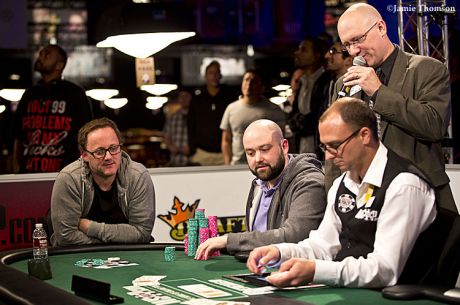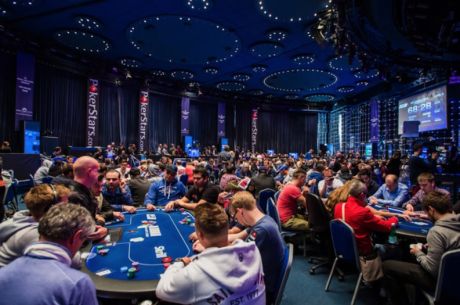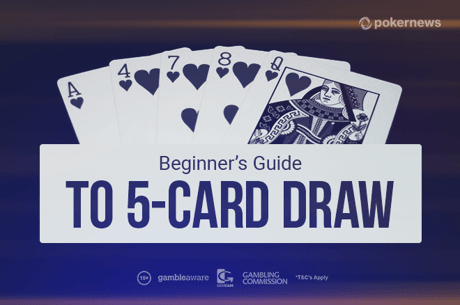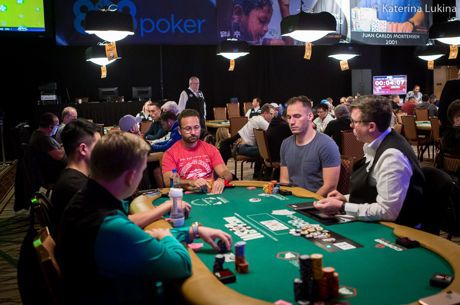Thinking Outside the Hold’em Box: Razz
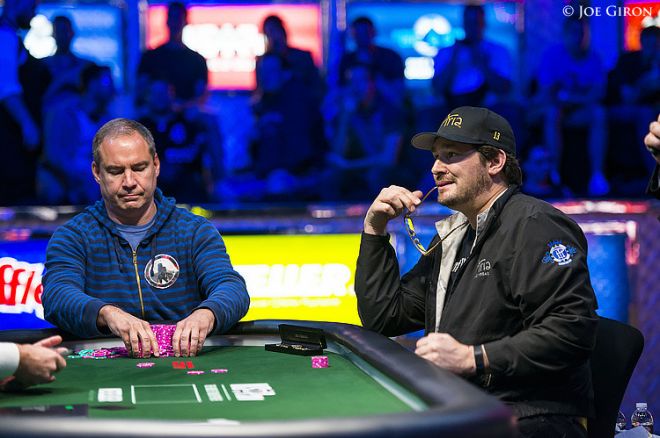
In this series I am discussing some of the poker variants other than no-limit hold’em you’ll probably hear about during coverage of this year’s World Series of Poker. If a game piques your interest, think about taking some time to explore it further. Who knows — you just might find a new game to love!
Razz
If you followed the updates from last year’s WSOP, you might remember one of the most exciting stories of the summer playing out in the $1,500 Seven-Card Razz event. There we witnessed the “Poker Brat” himself, Phil Hellmuth, entering the final table as one of the chip leaders, vying for what would have been a record-extending 14th bracelet.
After outlasting 350 other players, including several well-known poker pros at the final table such as David Bach, Brock Parker, and Brandon Cantu, Hellmuth ultimately went heads-up against fellow veteran Ted Forrest, a then-five-time bracelet winner himself.
Both Hellmuth and Forrest headed into their tournament-ending duel having earned one razz bracelet already, with each determined to win a second. The result was an epic, nail-biting, five-hour heads-up battle ultimately won by Forrest.
Will Hellmuth get his revenge this year? We’ll soon see! This year’s first razz event is the second $1,500 non-hold’em tournament on the WSOP schedule (Event #9), with the $10K Championship event also coming soon (Event #17). Last year’s $10K razz event was also noteworthy, with George Danzer breaking his WSOP title drought by besting an 112-player field and winning the first of three WSOP bracelets on his way to becoming the 2014 WSOP Player of the Year.
Hand Rankings
If you’re a NLHE player who feels "blessed" with the gift of consistently being dealt hands such as 7x2x, 6x3x, and 4x2x and any of a multitude of combinations of unappealing starters, then razz might just be the game for you.
The object of razz is quite simple: you want to make the lowest five-card hand. Players are dealt seven cards in total, and will choose the best five to show down.
The Ax plays as “1” and is the lowest-ranked card. Straights and flushes are ignored and do not count against hands. Therefore, the best hand in razz is 5x4x3x2xAx, which is made up of the five lowest-ranked cards — the “nut” razz hand, also known as a “Number One.”
You might recall from our previous “Thinking Outside the Hold’em Box” article the discussion of ranking low hands in the context of the game Omaha Hi-Low. There we talked about how ordering your best (i.e., lowest and uniquely ranked) five cards from highest to lowest rank can help you to read low hands. However, note that in razz there is no "qualifier" employed as it is in "Eight-or-Better" games such as Omaha Hi-Low.
Here are some example razz hands listed from best to worst:
- 5♠4♠3♥2♥A♣ — 5-high hand
- 6♦5♦4♠3♥2♣ — 6-high hand
- 7♣6♥5♣4♣A♣ — 7-high hand
- 9♣7♦6♥4♥3♥ — 9-high hand
- K♠7♥6♠5♠2♦ — K-high hand
- 3♠3♥7♣4♦2♥ — pair of threes
Play of the Hand
Razz is a type of stud game. The play of the hand proceeds generally in the same manner for all games of this type. Each player is initially dealt three cards — two face down, one face up. Players are then dealt four additional cards for a total of seven cards — three more face up, then the last one face down (as in seven-card stud and seven-card stud Hi-Low eight-or better).
There are five betting rounds, and the amount that can be bet and raised on each betting round is fixed. This means there is a low limit bet associated with the first two betting rounds, and a high limit bet associated with the last three. For example, in a game with limits identified as “100/200,” the low limit bet is 100 and the high limit bet is 200.
There are no blinds in razz. Instead, the forced bets driving the action in this game are antes and a bring-in bet. The bring-in is similar to a blind, in that the player who is forced to post it must do so — it is not optional. In razz, the player dealt the worst upcard (i.e., the highest-ranked upcard) must post the bring-in.
Once the player showing the worst upcard posts the bring-in, play on the first betting round proceeds clockwise. Anyone who wishes to stay in the hand can either call the bring-in, or “complete” to a full bet; on the first betting round, a full bet is the low limit bet. After someone has completed, subsequent players who wish to remain in the pot may call, or raise in increments of the low limit bet.
When the first betting round is over, each player is dealt an additional card. On this, and all future betting rounds, the betting begins with the player showing the “best hand” rather than the worst, based only on each player’s upcards. Once the betting action finishes, a further card is dealt to each remaining player and the betting actions are repeated until each player is dealt a total of seven cards and the final betting round is ended.
Basic Strategy Tips for Razz
Here are some recommended starting hands:
Group 1: Three different cards ranked six or lower

Being dealt one of these hands is extremely rare. The best of these hands would be Ax2x3x, since these are the three lowest-ranked cards. However, any three different-ranked “wheel” cards (i.e., cards ranked ace through five) will still provide you with an excellent headstart toward a very strong low hand. Sixes cannot be used to make the highest-ranking five-card hand, but are still valuable as a six is an essential component of many top razz hands.
Group 2: Three different cards headed by a seven or an eight
Being dealt one of these hands from the start is also quite rare. Obviously, a hand headed by a seven will generally be stronger than a hand headed by an eight. The stronger hands of this group will not have the highest-ranked card (i.e. the seven or the eight) exposed as an upcard. When a low-ranked upcard is showing and the highest-ranked card is hidden within your hole cards, it will be more difficult for opponents to judge accurately the strength of your hand as play progresses.
Given this short list, the default rule for selecting appropriate starting hands for razz would appear to be pretty straightforward: start with hands consisting of three low cards. Indeed, for novice players, this would be a reliable rule of thumb. In general, you want to start with cards ranked as low as possible to give yourself the best chance to ultimately make as low a hand as possible.
That said, in razz it is the relative strength of hands that matters most. For example, if you hold cards headed by a nine or ten (with no pair), but your opponents clearly hold worse hands (e.g., they all hold an exposed face card), then you can be confident your hand is currently best and should bet to try and make them all fold.
Keep in mind that high cards and pairs handicap your starting hand severely. Starting with a face card or a paired card means you will effectively need to make a strong five-card hand from only six cards. You then cannot afford to be dealt more than one bad card (“brick”) over the remaining draws.
However, there may occasionally be situations where you may be able to win a pot by betting because your upcards are low, even when you do not actually hold a strong hand. For example, earlier in “Negreanu on Twitch: Five Helpful Tips for Improving Your Mixed Games Play... In Bed,” I discussed how if everyone folds to you and you have a low upcard showing and are facing a high-ranked upcard of the bring-in, that presents a good opportunity to steal.
Whenever you show a much stronger set of upcards relative to those of your opponents, your opponents might fold when you bet in fear of the excellent hand you are representing. This is the most common way that bluffs are executed in razz.
Ken Lo is the author of A Poker Player’s Guide to Mixed Games: Core Strategies for HORSE, Eight-Game, Ten-Game, and Twelve-Game Mixes. He is based in Toronto, Canada. Follow him on Twitter @ppgmg.
Want to stay atop all the latest in the poker world? If so, make sure to get PokerNews updates on your social media outlets. Follow us on Twitter and find us on both Facebook and Google+!
In this Series
- 1 Thinking Outside the Hold’em Box: Limit Omaha Hi-Low Split (Eight-or-Better)
- 2 Thinking Outside the Hold’em Box: Razz
- 3 Thinking Outside the Hold’em Box: No-Limit Deuce-to-Seven Single Draw
- 4 Thinking Outside the Hold’em Box: Deuce-to-Seven Triple Draw
- 5 Thinking Outside the Hold’em Box: Badugi
- 6 Thinking Outside the Hold’em Box: Dealer’s Choice

